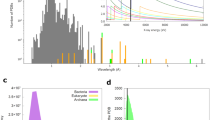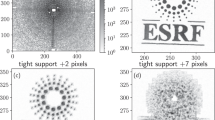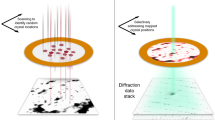Abstract
The accuracy of X-ray diffraction data is directly related to how the X-ray detector records photons. Here we describe the application of a direct-detection charge-integrating pixel-array detector (JUNGFRAU) in macromolecular crystallography (MX). JUNGFRAU features a uniform response on the subpixel level, linear behavior toward high photon rates, and low-noise performance across the whole dynamic range. We demonstrate that these features allow accurate MX data to be recorded at unprecedented speed. We also demonstrate improvements over previous-generation detectors in terms of data quality, using native single-wavelength anomalous diffraction (SAD) phasing, for thaumatin, lysozyme, and aminopeptidase N. Our results suggest that the JUNGFRAU detector will substantially improve the performance of synchrotron MX beamlines and equip them for future synchrotron light sources.
This is a preview of subscription content, access via your institution
Access options
Access Nature and 54 other Nature Portfolio journals
Get Nature+, our best-value online-access subscription
$29.99 / 30 days
cancel any time
Subscribe to this journal
Receive 12 print issues and online access
$259.00 per year
only $21.58 per issue
Buy this article
- Purchase on Springer Link
- Instant access to full article PDF
Prices may be subject to local taxes which are calculated during checkout






Similar content being viewed by others
Data availability
All diffraction data have been deposited in the figshare depository and are accessible at https://doi.org/10.6084/m9.figshare.6087368. Diffraction data and refined models for native-SAD structures have been deposited in the Protein Data Bank as PDB 6G89 (thaumatin), 6G8A (lysozyme), and 6G8B (PepN). Source data for Figs. 2–6 are available online.
References
Jaskolski, M., Dauter, Z. & Wlodawer, A. A brief history of macromolecular crystallography, illustrated by a family tree and its Nobel fruits. FEBS. J. 281, 3985–4009 (2014).
Duke, E. M. H. & Johnson, L. N. Macromolecular crystallography at synchrotron radiation sources: current status and future developments. Proc. R. Soc. Lond. A Math. Phys. Eng. Sci. 466, 3421–3452 (2010).
Gruner, S. M., Eikenberry, E. F. & Tate, M. W. in International Tables for Crystallography 2nd edn, Vol. F (eds Rossmann, M. G., Himmel, D. M. & Arnold, E.) 177–182 (International Union of Crystallography, Chester, UK, 2012).
von Seggern, H. Photostimulable x-ray storage phosphors: a review of present understanding. Brazilian Journal of Physics 29, 254–268 (1999).
Howard, A. J. et al. The use of an imaging proportional counter in macromolecular crystallography. J. Appl. Crystallogr. 20, 383–387 (1987).
Arndt, U. W. X‐ray television area detectors. Synchrotron Radiat. News 3, 17–22 (1990).
Gruner, S. M., Tate, M. W. & Eikenberry, E. F. Charge-coupled device area x-ray detectors. Rev. Sci. Instrum. 73, 2815–2842 (2002).
Graafsma, H. in Semiconductor Radiation Detection Systems (ed Iniewski, K.) 217–236 (CRC Press, Boca Raton, FL, 2010).
Waterman, D. & Evans, G. Estimation of errors in diffraction data measured by CCD area detectors. J. Appl. Crystallogr. 43, 1356–1371 (2010).
Dauter, Z. Data-collection strategies. Acta Crystallogr. D Biol. Crystallogr. 55, 1703–1717 (1999).
Broennimann, Ch. et al. The PILATUS 1M detector. J. Synchrotron. Radiat. 13, 120–130 (2006).
Mueller, M., Wang, M. & Schulze-Briese, C. Optimal fine φ-slicing for single-photon-counting pixel detectors. Acta Crystallogr. D Biol. Crystallogr. 68, 42–56 (2012).
Dinapoli, R. et al. EIGER: next generation single photon counting detector for X-ray applications. Nucl. Instrum. Methods. Phys. Res. A 650, 79–83 (2011).
Casanas, A. et al. EIGER detector: application in macromolecular crystallography. Acta Crystallogr. D Struct. Biol. 72, 1036–1048 (2016).
Wojdyla, J. A. et al. Fast two-dimensional grid and transmission X-ray microscopy scanning methods for visualizing and characterizing protein crystals. J. Appl. Crystallogr. 49, 944–952 (2016).
Diederichs, K. & Wang, M. in Protein Crystallography: Methods and Protocols (eds Wlodawer, A., Dauter, Z. & Jaskolski, M.) 239–272 (Humana Press, New York, 2017).
Ballabriga, R. et al. The Medipix3RX: a high resolution, zero dead-time pixel detector readout chip allowing spectroscopic imaging. J. Instrum. 8, C02016 (2013).
Sobott, B. A. et al. Success and failure of dead-time models as applied to hybrid pixel detectors in high-flux applications. J. Synchrotron. Radiat. 20, 347–354 (2013).
Loeliger, T. et al. in 2012 IEEE Nuclear Science Symposium and Medical Imaging Conference Record (NSS/MIC) (ed Yu, B.) 610–615 (IEEE, New York, 2012).
Eriksson, M., van der Veen, J. F. & Quitmann, C. Diffraction-limited storage rings—a window to the science of tomorrow. J. Synchrotron. Radiat. 21, 837–842 (2014).
Denes, P. & Schmitt, B. Pixel detectors for diffraction-limited storage rings. J. Synchrotron. Radiat. 21, 1006–1010 (2014).
Graafsma, H., Becker, J. & Gruner, S. M. in Synchrotron Light Sources and Free-Electron Lasers (eds Jaeschke, E. et al.) 1029–1054 (Springer, Cham, 2016).
Tate, M. W. et al. A medium-format, mixed-mode pixel array detector for kilohertz X-ray imaging. J. Phys. Conf. Ser. 425, 062004 (2013).
Mozzanica, A. et al. Characterization results of the JUNGFRAU full scale readout ASIC. J. Instrum. 11, C02047 (2016).
Chapman, H. N. et al. Femtosecond X-ray protein nanocrystallography. Nature 470, 73–77 (2011).
Redford, S. et al. First full dynamic range calibration of the JUNGFRAU photon detector. J. Instrum. 13, C01027 (2018).
Liu, Q. et al. Structures from anomalous diffraction of native biological macromolecules. Science 336, 1033–1037 (2012).
Weinert, T. et al. Fast native-SAD phasing for routine macromolecular structure determination. Nat. Methods 12, 131–133 (2015).
Terwilliger, T. C. et al. Can I solve my structure by SAD phasing? Anomalous signal in SAD phasing. Acta Crystallogr. D Struct. Biol. 72, 346–358 (2016).
Sheldrick, G. M. Experimental phasing with SHELXC/D/E: combining chain tracing with density modification. Acta Crystallogr. D Biol. Crystallogr. 66, 479–485 (2010).
Skubák, P. & Pannu, N. S. Automatic protein structure solution from weak X-ray data. Nat. Commun. 4, 2777 (2013).
Garman, E. F. Radiation damage in macromolecular crystallography: what is it and why should we care? Acta Crystallogr. D Biol. Crystallogr. 66, 339–351 (2010).
Neutze, R. & Moffat, K. Time-resolved structural studies at synchrotrons and X-ray free electron lasers: opportunities and challenges. Curr. Opin. Struct. Biol. 22, 651–659 (2012).
Gati, C. et al. Serial crystallography on in vivo grown microcrystals using synchrotron radiation. IUCrJ 1, 87–94 (2014).
Weinert, T. et al. Serial millisecond crystallography for routine room-temperature structure determination at synchrotrons. Nat. Commun. 8, 542 (2017).
Beyerlein, K. R. et al. Mix-and-diffuse serial synchrotron crystallography. IUCrJ 4, 769–777 (2017).
Gruner, S. M. & Lattman, E. E. Biostructural science inspired by next-generation X-ray sources. Annu. Rev. Biophys. 44, 33–51 (2015).
Meents, A. et al. Pink-beam serial crystallography. Nat. Commun. 8, 1281 (2017).
Barty, A. et al. Cheetah: software for high-throughput reduction and analysis of serial femtosecond X-ray diffraction data. J. Appl. Crystallogr. 47, 1118–1131 (2014).
Mariani, V. et al. OnDA: online data analysis and feedback for serial X-ray imaging. J. Appl. Crystallogr. 49, 1073–1080 (2016).
Zeldin, O. B. et al. Data Exploration Toolkit for serial diffraction experiments. Acta Crystallogr. D Biol. Crystallogr. 71, 352–356 (2015).
Wojdyla, J. A. et al. DA+ data acquisition and analysis software at the Swiss Light Source macromolecular crystallography beamlines. J. Synchrotron. Radiat. 25, 293–303 (2018).
Redford, S. et al. Calibration status and plans for the charge integrating JUNGFRAU pixel detector for SwissFEL. J. Instrum. 11, C11013 (2016).
Bernstein, H. J. & Hammersley, A. P. in International Tables for Crystallography Vol. G (eds Hall, S. R. & McMahon, B.) 37–43 (International Union of Crystallography, Chester, UK, 2006).
Peng, G. et al. Insight into the remarkable affinity and selectivity of the aminobenzosuberone scaffold for the M1 aminopeptidases family based on structure analysis. Proteins 85, 1413–1421 (2017).
Paithankar, K. S., Owen, R. L. & Garman, E. F. Absorbed dose calculations for macromolecular crystals: improvements to RADDOSE. J. Synchrotron. Radiat. 16, 152–162 (2009).
Kabsch, W. XDS. Acta Crystallogr. D Biol. Crystallogr. 66, 125–132 (2010).
Pape, T. & Schneider, T. R. HKL2MAP: a graphical user interface for macromolecular phasing withSHELXprograms. J. Appl. Crystallogr. 37, 843–844 (2004).
Thorn, A. & Sheldrick, G. M. ANODE: anomalous and heavy-atom density calculation. J. Appl. Crystallogr. 44, 1285–1287 (2011).
Afonine, P. V. et al. Towards automated crystallographic structure refinement with phenix.refine. Acta Crystallogr. D Biol. Crystallogr. 68, 352–367 (2012).
Diederichs, K. & Karplus, P. A. Improved R-factors for diffraction data analysis in macromolecular crystallography. Nat. Struct. Biol. 4, 269–275 (1997).
Johnson, I. et al. Eiger: a single-photon counting x-ray detector. J. Instrum. 9, C05032 (2014).
Acknowledgements
The project was funded by the Paul Scherrer Institute. We thank C. Tarnus, C. Schmitt, and S. Albrecht for the preparation of PepN crystals.
Author information
Authors and Affiliations
Contributions
M.W., O.B., and B.S. conceived the research; S.R., A.M., and C.L.-C. built and calibrated the JF1M detector; A.M., D.B., and R.S. installed JF1M and E1M detectors at beamline X06SA; F.L., A.M., and E.P. developed diffraction-data collection software; L.V. and V.O. prepared samples; F.L., S.R., A.M., E.P., and M.W. collected data; F.L., S.R., K.N., D.O., G.T., E.F., K.D., and M.W. analyzed data; and F.L., S.R., O.B., and M.W. wrote the manuscript with contributions from all other authors.
Corresponding authors
Ethics declarations
Competing interests
The authors declare no competing interests.
Additional information
Publisher’s note: Springer Nature remains neutral with regard to jurisdictional claims in published maps and institutional affiliations.
Integrated supplementary information
Supplementary Figure 1
Experimental setup with a JUNGFRAU 1M detector at the X06SA beamline, SLS.
Supplementary Figure 2 Spatial profile of Bragg spots from a thaumatin crystal (Thau2).
One diffraction image and reflection profiles of six reflections from different resolution shells and regions of the E1M detector are shown. To obtain full reflections, the image presented here corresponds to 1.76o rotation of the crystal (sum of 20 frames). Reflections are about single pixel wide horizontally but elongated vertically.
Supplementary Figure 3 Comparison of 6-keV data from a thaumatin crystal measured with JUNGFRAU and EIGER detectors (two threshold settings for EIGER).
The <I/σ>mrgd values are plotted as a function of resolution.
Supplementary information
Supplementary Text and Figures
Supplementary Figs. 1–3 and Supplementary Tables 1–6
Rights and permissions
About this article
Cite this article
Leonarski, F., Redford, S., Mozzanica, A. et al. Fast and accurate data collection for macromolecular crystallography using the JUNGFRAU detector. Nat Methods 15, 799–804 (2018). https://doi.org/10.1038/s41592-018-0143-7
Received:
Accepted:
Published:
Issue Date:
DOI: https://doi.org/10.1038/s41592-018-0143-7
This article is cited by
-
Directed ultrafast conformational changes accompany electron transfer in a photolyase as resolved by serial crystallography
Nature Chemistry (2024)
-
Chemical crystallography by serial femtosecond X-ray diffraction
Nature (2022)
-
A detector for the sources
Nature Methods (2018)



